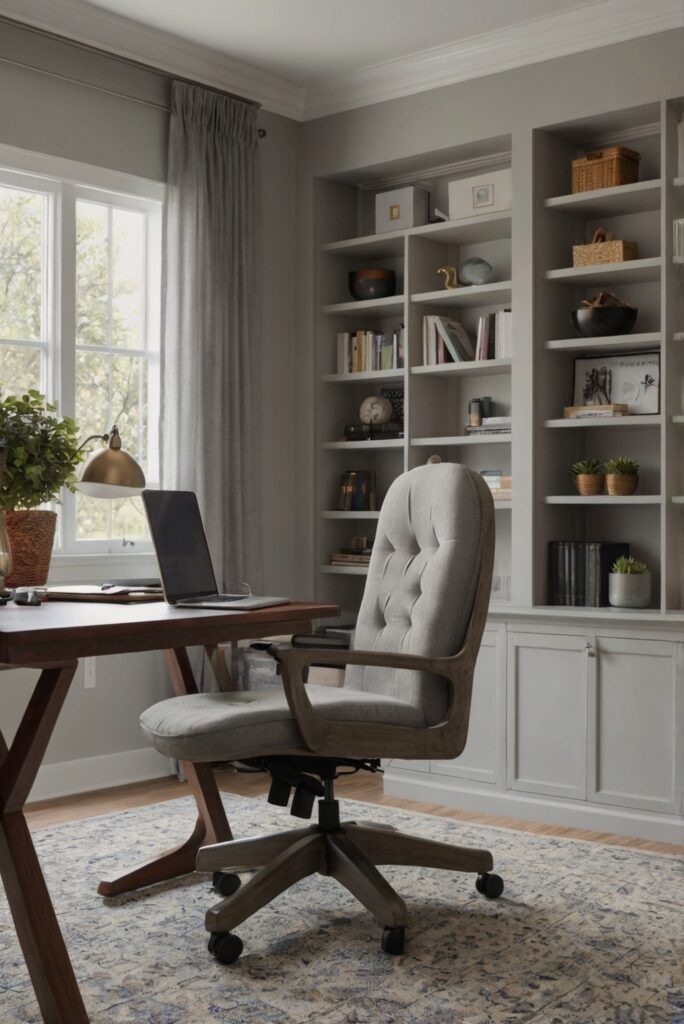Enhance your home office desk setup with ergonomic principles for a functional and stylish workspace. Discover practical tips and design ideas in this daily routine for interior designers.
To incorporate ergonomics into your home office desk setup as part of your daily routine in home decorating, consider the following ideas:
1. Select a desk and chair with adjustable heights to suit your needs for an ergonomic workspace.
2. Use a monitor stand to keep your screen at eye level and prevent neck strain.
3. Keep frequently used items within easy reach to minimize repetitive reaching and twisting movements.
4. Use a wrist rest and ergonomic keyboard to prevent strain on your wrists and hands.
5. Ensure proper lighting in your workspace to reduce eye strain and fatigue.
6. Add plants or decor elements to create a visually pleasing and calming work environment.
Incorporating ergonomics into your home office desk setup is beneficial for your overall well-being and productivity.
How to Incorporate Ergonomics into Your Home Office Desk Setup?
When setting up your home office desk, it is crucial to prioritize ergonomics to ensure maximum comfort and productivity. Here are some tips to help you incorporate ergonomics into your workspace:
Adjust Your Chair
Start by adjusting your chair to the correct height so that your feet are flat on the floor and your knees are at a 90-degree angle. Ensure that your lower back is supported by the chair’s backrest, and use a cushion if necessary. This will help prevent back pain and improve your posture.
Position Your Monitor
Place your monitor directly in front of you at arm’s length, with the top of the screen at or slightly below eye level. This will help reduce strain on your neck and eyes. Use a monitor stand or adjustable arm to achieve the optimal height and angle.
Organize Your Desk
Keep frequently used items within arm’s reach to minimize reaching and twisting. Use a keyboard tray to keep your keyboard at elbow height and your wrists straight while typing. Keep your desk clutter-free to create a more organized and efficient workspace.
Use Proper Lighting
Ensure that your workspace is well-lit to reduce eye strain. Position your desk lamp to illuminate your work area without causing glare on your screen. Natural light is ideal, so try to position your desk near a window if possible.
Take Breaks and Stretch
Remember to take regular breaks to rest your eyes and stretch your muscles. Follow the 20-20-20 rule: every 20 minutes, look at something 20 feet away for at least 20 seconds. Incorporate stretching exercises into your daily routine to prevent stiffness and improve circulation.
Incorporating ergonomics into your home office desk setup is essential for maintaining your health and well-being. By following these tips, you can create a comfortable and productive workspace that supports your overall work performance. Remember to regularly assess your setup and make adjustments as needed to ensure optimal ergonomics.
What is ergonomics and why is it important for your home office desk setup?
Ergonomics is the study of designing equipment and devices that fit the human body’s natural movements and capabilities. In the context of a home office desk setup, ergonomics is crucial as it helps prevent musculoskeletal disorders, improves productivity, and enhances overall well-being. By incorporating ergonomic principles into your workspace, you can reduce the risk of repetitive strain injuries and discomfort, leading to a more comfortable and efficient work environment.
What are the key elements of an ergonomic home office desk setup?
The key elements of an ergonomic home office desk setup include an adjustable chair with proper lumbar support, a desk at the correct height to promote good posture, a monitor positioned at eye level to reduce neck strain, and a keyboard and mouse placed within easy reach to prevent wrist and arm strain. Additionally, proper lighting, organization of supplies, and regular breaks are essential components of an ergonomic workspace.
How can you adjust your home office desk setup to be more ergonomic?
To adjust your home office desk setup to be more ergonomic, start by ensuring your chair is at the correct height so your feet are flat on the floor and your thighs are parallel to the ground. Position your desk and monitor to maintain a neutral neck and eye level alignment. Use a keyboard tray to keep your wrists straight and invest in an ergonomic mouse for comfortable use. Consider adding a footrest for added support and incorporating standing or walking breaks throughout the day to reduce sedentary behavior.
What are some ergonomic accessories that can enhance your home office desk setup?
Ergonomic accessories such as an adjustable monitor stand, a document holder to reduce neck strain, a wrist rest for keyboard support, and a lumbar cushion for additional back support can enhance your home office desk setup. Standing desks or desk converters can also provide the option to alternate between sitting and standing, promoting better circulation and reducing the risk of sedentary-related health issues.
What are some additional tips for maintaining an ergonomic home office desk setup?
In addition to the physical setup of your workspace, it’s important to take regular breaks to stretch and move around, practice good posture habits, stay hydrated, and adjust your workstation based on your individual needs and comfort. Consider consulting with an ergonomics specialist for personalized recommendations and invest in high-quality ergonomic furniture and equipment to create a comfortable and productive home office environment.

